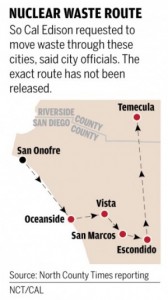Nuclear Shipments to Cross Region, But Officials Won’t Say Where – San Onofre
Four enormous but lightly radioactive nuclear components will move across North County and Southwest Riverside County sometime in the coming weeks with a level of secrecy usually reserved for a presidential motorcade.
The route is not being shared with the public. Only those directly involved in moving the equipment or permitting the trip know exactly how and where the components —- four recently removed steam generators from San Onofre Nuclear Generating Station —- will move through San Diego, Riverside and San Bernardino counties en route to a final disposal site in Clive, Utah.
But officials from several cities in the region —- Oceanside, Vista, San Marcos, Escondido and Temecula —- say they have received permit requests from plant owner Southern California Edison to move the equipment in four separate shipments through their towns.
Those city officials deferred to Edison; none would immediately disclose which roads will be used to haul the massive loads, which weigh 380 tons and measure 46 feet long and 14 feet in diameter. (An official in Temecula said Thursday that he first needed to determine whether the permit is a public record.)
The generators contain none of the radioactive water that once pumped through their innards; they are empty vessels classified as “low-level nuclear waste” by the U.S. Nuclear Regulatory Commission.
Southern California Edison has said that the shipments are perfectly safe, but has also cited “security concerns” as a reason for withholding the routes.
When asked to be specific, Edison spokesman Gil Alexander said only that “several law enforcement and security organizations have advised … that it is a prudent security measure not to disclose the exact route and schedule because of issues related to traffic control.”
He said the shipments are to move late at night when traffic is lighter.
David Lochbaum, director of the Nuclear Safety Project at the Union for Concerned Scientists, an environmental advocacy group, said concerns about terrorism and protests have typically caused the government to be vague about transport routes for such materials.
A trained nuclear engineer, Lochbaum said the used generators are so massive, and their radioactive content so comparatively weak, that they wouldn’t make a very compelling terror target.
Still, he said, he agrees the route should remain a secret because an accident involving one of the behemoths could cause the perception of nuclear difficulty, even if none exists.
“It’s hard to argue that they’re not doing the right thing in that regard,” he said.
The shipments were scheduled to leave San Onofre on June 19, but were delayed until mid- to late July because the utility is “still finalizing” transport permits with Caltrans and the California Coastal Commission, Alexander said.
Neither state agency responded to a request for more information on what details remain before permits are issued.
The components in question have spent most of their lives under San Onofre Nuclear Generating Station’s massive concrete containment domes.
For decades, they helped convert the heat of nuclear fission into steam used to spin the plant’s electricity-generating turbines. Over the last two years, Edison replaced the large metal capsules with nearly identical new units after engineers spotted microscopic cracks in some of the generator’s internal plumbing.

